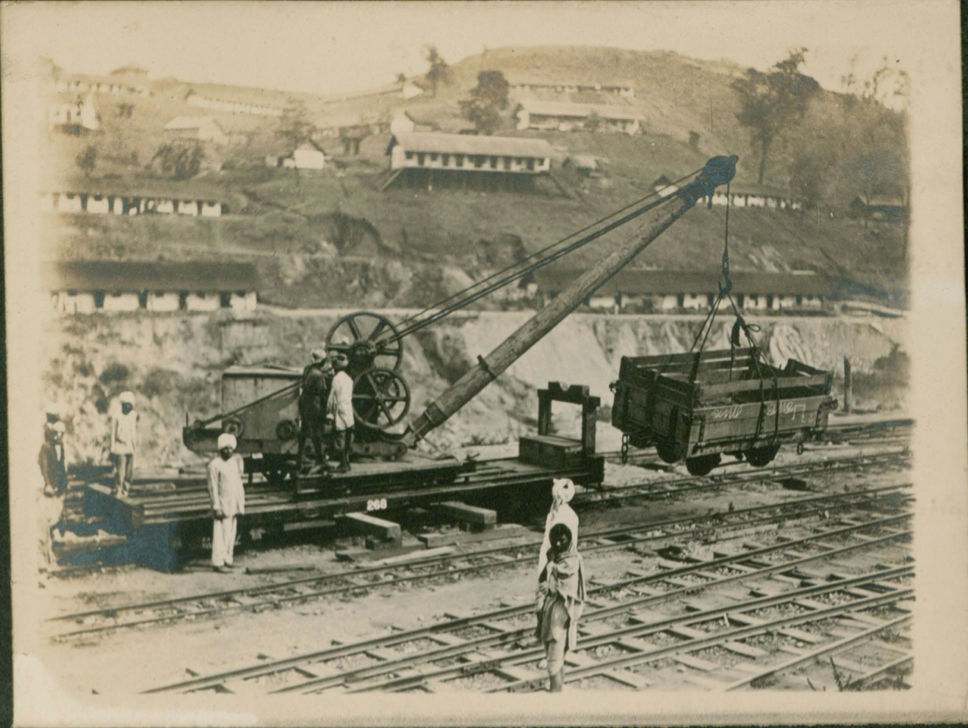The image that I have selected was taken in 1917. I am unsure of the precise location of the image but according to the collection it is either Burma, Penang, or China. The author of the image, George West Philleo titled the collection, Burma, Penang, and China in the 1920s. I believe that the location of the image is a trade route through a rural countryside. In the past I believe that the railroad tracks were not there but instead it was a walking or horse travel route, before industrialization, between destinations. I also believe that the lodges in the background were previously camping grounds along the route and it had not yet been developed into a village of its own. Since the lodges are developed in the image I am inferring that behind the photographer, which is not shown, is a body of water such as a lake, pond, river, or another source of water in order to provide the necessary resources to survive on the journey across the route. I believe that that is the reason why the lodges were developed there because of the access to water.
At the time the image was taken you can see an introduction into industrialization as there is machinery in the form of a wooden crane with a basic pulley system and a wooden mine-cart seemingly missing some pieces. While these pieces of equipment are basic, they are the first steps into the world of industrialization and could foresee humongous mechanical cranes in the future with dozens of pieces of hardware to make the job more efficient and effective. I also believe that the lodges in the background are housing for the workers and their families because it does not appear that a village is nearby. With the homes appearing to be in the countryside, as I previously mentioned, there must be a source of water nearby otherwise the homes would not be able to operate for a prolonged period of time.
Currently, as it would be the future since this image was taken, I still believe that the area is a railroad and trade route, however, it has been modernized. According to the Travel China Guide (TCG), China has over 5,500 railway stations (TCG) demonstrating the importance of railroads. The significance of that is that China understands how valuable railroads can be for transportation of goods and people and that without these rural railroads and the workers who live there, the entire system would fail. This image represents the small details of the world that allow it to function properly. I believe that George West Philleo took and included this image in his collection to emphasize how some things just don’t change. They may evolve and develop new technologies or more developed areas but in its essence, this area will always be a railroad and a medium between destinations that helps the nation thrive.
Now, if we were to look into the future compared to now of the area in the image, based on information provided by the International Energy Agency (IEA), “freight activity will more than double by 2050” (IEA) due to the railways’ abilities to transport mass amounts of freight while lowering CO2 emissions. The relevance of this data for the image is that the area will gradually continue to develop in order to keep up with the constant demands for goods and will have to find a way to modernize itself to become less harmful to the environment, otherwise the process of railroads will be no better for the world as it would cause equal harm to the good it does. A question that has been on my mind has been, how when the image was originally taken could George West Philleo have known the importance of railroads in the advancement of modern technology?
I have questioned many people about the image and the most common response is the person or people just describing the image and assuming that it is probably a railroad still. While that is not a wrong answer, no one has yet begun to describe the importance of railroads and the role they contribute to society. More specifically, no one has brought up the importance of the people in the image. These workers are the foundation of making sure the cargo can get properly transported from one location to the next and without them, people would not get the items they need in order to continue to develop the country which in turn would help move the world forward. According to the Union Pacific, during the time of the Covid-19 pandemic, railroad workers were deemed, “essential critical infrastructure workers,” (UP), just emphasizing the importance of them and how without them, transit infrastructure would fail causing unspeakable panic in the world. Overall, I believe that the image has much more depth beyond its surface and that it symbolizes the process of railroads which keeps the world steaming ahead.
